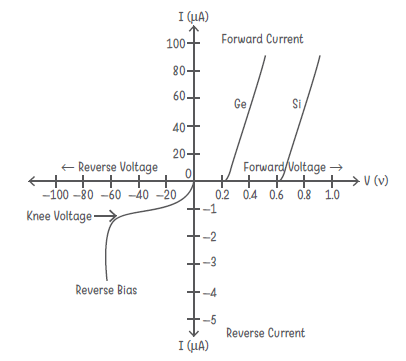Semiconductor Electronics Class 12 Notes Physics Chapter 14 - CBSE
Chapter : 14
What are Semiconductor Electronics: Materials, Devices And Simple Circuits ?
https://drive.google.com/file/d/1uIBewo-8hpwtxQnwMKKA443BqsjZj0lL/view
| Term | Definition / Important Points |
| Classification of solids on the basis of band theory |
|
| Semiconductors |
|
| Intrinsic Semiconductors |
(i) n-type semiconductor : When a pure semiconductor is doped with a pentavalent impurity, we obtain a n-type semiconductor. (ii) p-type semiconductor : When a pure semiconductor is doped with a trivalent impurity, we obtain a p-type semiconductor. |
| Semiconductor Diode | A semiconductor diode, the most commonly used type today, is a crystalline piece of semiconductor material with a p-n junction connected to two electrical terminals. |
Some Important Concepts
| Term | Definition / Important Points |
| p-n Junction Diode |
|
| I-V characteristics of a p-n junction |  |
|
|
| Knee Voltage | |
| Diode as a Rectifier |
(i) Half Wave Rectifier (ii) Full Wave Rectifier |
Share page on
Chapterwise Notes Class 12 Physics
- Electric Charges And Fields
- Electrostatic Potential And Capacitance
- Current Electricity
- Moving Charges And Magnetism
- Magnetism And Matter
- Electromagnetic Induction
- Alternating Current
- Electromagnetic Waves
- Ray Optics And Optical Instruments
- Wave Optics
- Dual Nature Of Radiation And Matter
- Atoms
- Nuclei
- Semiconductor Electronics: Materials, Devices And Simple Circuits
CBSE CLASS 12 Notes
- CBSE Class 12 Physics Notes
- CBSE Class 12 Chemistry Notes
- CBSE Class 12 Biology Notes
- CBSE Class 12 Maths Notes
- CBSE Class 12 Accountancy Notes
- CBSE Class 12 Business Studies Notes
- CBSE Class 12 Economics Notes
- CBSE Class 12 History Notes
- CBSE Class 12 Geography Notes
- CBSE Class 12 Political Science Notes
CBSE CLASS 12 SYLLABUS
- CBSE Class 12 English core Syllabus
- CBSE Class 12 Mathematics Syllabus
- CBSE Class 12 Physics Syllabus
- CBSE Class 12 Chemistry Syllabus
- CBSE Class 12 Biology Syllabus
- CBSE Class 12 Accountancy Syllabus
- CBSE Class 12 Business Studies Syllabus
- CBSE Class 12 Economics Syllabus
- CBSE Class 12 History Syllabus
- CBSE Class 12 Geography Syllabus
- CBSE Class 12 Political science Syllabus
- CBSE Class 12 Sociology Syllabus
- CBSE Class 12 Psychology Syllabus
- CBSE Class 12 Physical education Syllabus
- CBSE Class 12 Applied mathematics Syllabus
- CBSE Class 12 History of Indian Arts Syllabus

